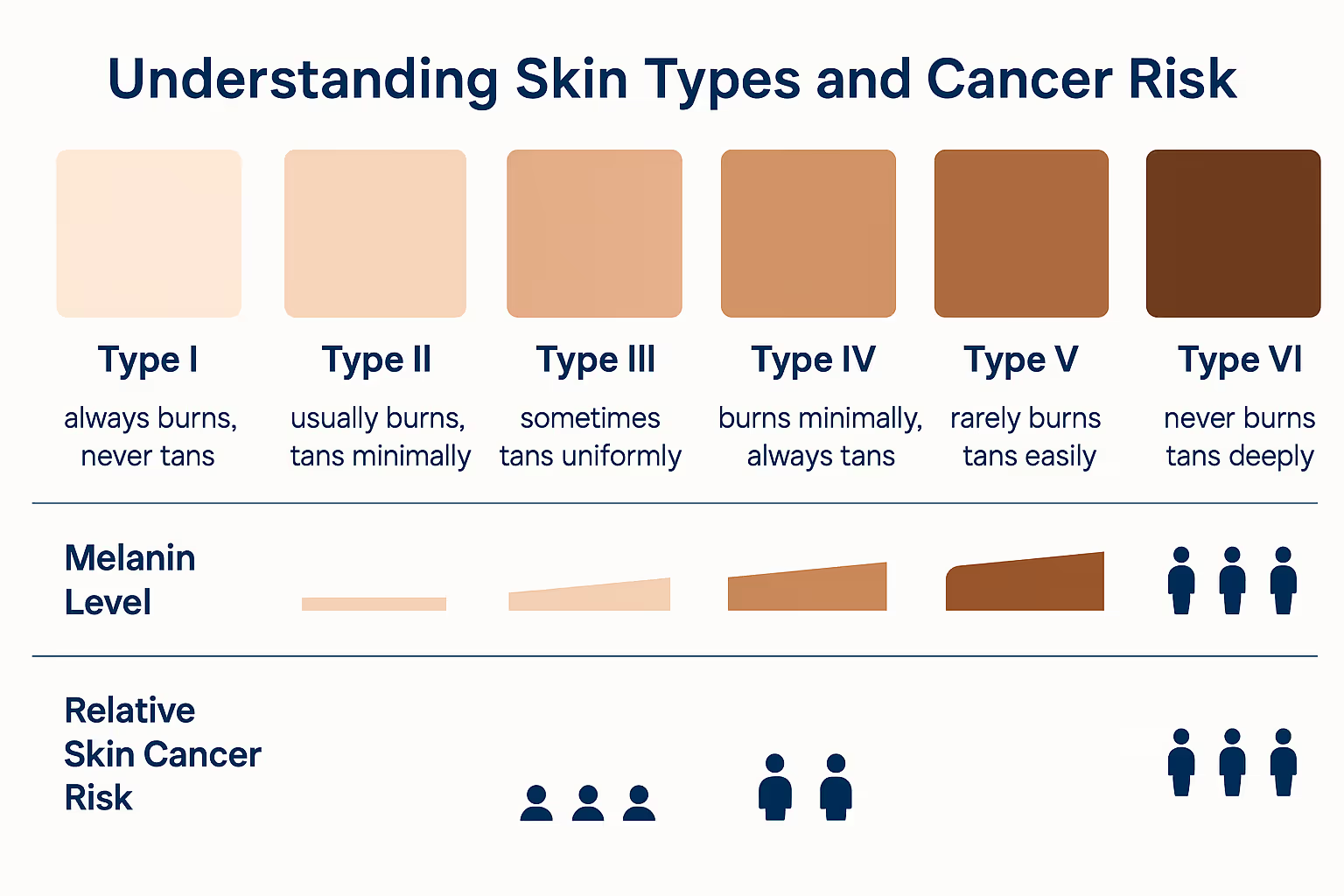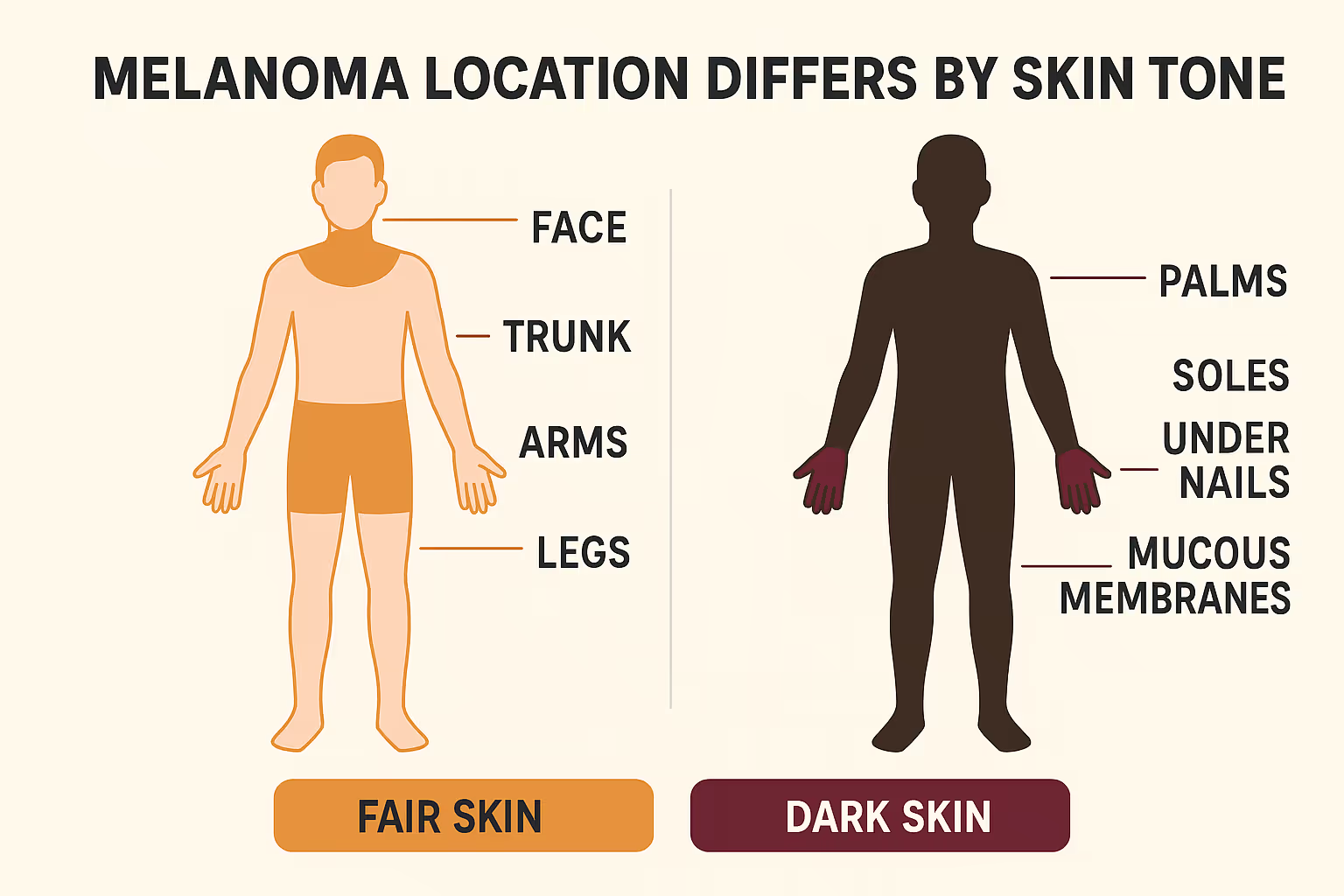When most people picture someone at high risk for skin cancer, they imagine someone with fair skin, light eyes, and a tendency to burn. But here's the truth that could save your life: skin cancer doesn't discriminate. While fair-skinned individuals do face higher statistical risk, people with darker skin tones can and do develop skin cancer—often with more serious consequences because it's detected later.
Understanding how skin cancer affects different skin tones isn't just about statistics. It's about recognizing warning signs, knowing where to look, and getting the expert care you deserve when something doesn't seem right.
Skin cancer is the most common cancer in the United States, affecting millions of people every year. But the way it develops, appears, and progresses can vary significantly based on your skin tone and melanin levels.
Your skin's natural melanin provides some protection against ultraviolet (UV) radiation, but it's not a force field. Think of it more like a built-in SPF—helpful, but not foolproof. People with darker skin have more melanin, which offers greater natural protection. However, this biological advantage comes with a dangerous downside: a false sense of security and delayed diagnosis.
Melanin is the pigment that gives your skin its color. It's produced by specialized cells called melanocytes, and it absorbs UV radiation to protect your skin cells from damage. The more melanin you have, the more natural protection you get.
Here's how dermatologists classify skin types using the Fitzpatrick Scale:
Skin TypeDescriptionMelanin LevelBurn/Tan ResponseType IVery fair, pale whiteLowestAlways burns, never tansType IIFair, white to light beigeLowUsually burns, tans minimallyType IIIMedium, beige with golden undertoneModerateSometimes burns, tans uniformlyType IVOlive, moderate brownModerate-HighRarely burns, tans easilyType VBrown, dark brownHighVery rarely burns, tans very easilyType VIVery dark brown to blackHighestNever burns, deeply pigmented
While Types I and II face the highest statistical risk for skin cancer, no skin type is immune. That's a critical message that doesn't get shared enough.
If you have fair skin, you've probably heard the warnings your whole life. And the statistics back them up: fair-skinned individuals have a significantly higher lifetime risk of developing skin cancer, particularly melanoma.
Fair skin contains less melanin, which means:
People with fair skin, light hair, blue or green eyes, and a history of sunburns face the highest risk. Just one blistering sunburn in childhood or adolescence more than doubles your risk of melanoma later in life.
Fair-skinned individuals are more likely to develop:
Basal Cell Carcinoma (BCC)
Squamous Cell Carcinoma (SCC)
Melanoma
"The good news is that when skin cancer is detected early in fair-skinned patients, treatment outcomes are excellent. The key is regular self-checks and annual skin exams with a professional." — Dermatology experts
If you have fair skin, you should be checking for:
The ABCDE rule is your friend:
Here's what many people don't realize: while skin cancer is less common in people with darker skin, the outcomes are often worse. Five-year melanoma survival rates are significantly lower in Black patients compared to white patients—not because the cancer is more aggressive, but because it's typically found at later stages.
Several factors contribute to later detection in darker skin:
1. Lower Awareness Many people with darker skin believe they're not at risk, so they don't perform self-checks or seek professional screenings.
2. Different Presentation Skin cancer in darker skin often appears in unexpected locations and may not look like the "typical" warning signs shown in most educational materials.
3. Healthcare Disparities Studies show that Black patients are less likely to receive thorough skin examinations during routine healthcare visits.
4. Visual Challenges Some skin changes are simply harder to detect on darker skin, even for trained professionals without proper examination techniques.
This is crucial: melanoma in darker-skinned individuals often develops in areas that receive little sun exposure. This pattern is called acral lentiginous melanoma (ALM).
Common locations include:
This is the same type of melanoma that took reggae legend Bob Marley's life. It started as a dark spot under his toenail—a location many people wouldn't think to check or worry about.
If you have darker skin, pay special attention to:
Don't ignore changes just because they're in unusual places or don't match the "typical" skin cancer pictures you've seen online.

Let's dispel a dangerous myth right now: darker skin does not mean you can skip sun protection.
While melanin provides some natural UV protection (roughly equivalent to SPF 13 in very dark skin), it's not enough to prevent all damage. UV radiation still penetrates the skin, causes DNA damage, and contributes to skin cancer risk—just at lower rates.
For Fair Skin (Types I-II):
For Medium Skin (Types III-IV):
For Dark Skin (Types V-VI):
Skin cancer risk isn't just about the sun. Other factors include:
Regardless of your skin tone, early detection dramatically improves outcomes. Most skin cancers are highly treatable when caught early, including melanoma.
Set aside 10-15 minutes once a month in a well-lit room with a full-length mirror and a hand mirror:
Step 1: Examine your face, neck, ears, and scalp (use a comb to part hair)
Step 2: Check your hands—front, back, between fingers, and under nails
Step 3: Stand in front of the mirror and check your arms, underarms, chest, and abdomen
Step 4: Examine your back, buttocks, and back of legs using the hand mirror
Step 5: Sit down and check the front of your legs, feet, between toes, and soles
Step 6: Use the hand mirror to check your genital area
Pro tip: Take photos of any moles or spots you're monitoring. This creates a visual record that makes it easier to spot changes over time.
Don't wait for your annual checkup if you notice:
At The Minor Surgery Center, we specialize in evaluating and removing concerning skin lesions quickly and professionally. No long wait times, no runaround—just expert care when you need it.
If you or your doctor spots something concerning, the next step is typically a biopsy. This is the only way to definitively diagnose skin cancer.
Shave Biopsy
Punch Biopsy
Excisional Biopsy
The procedure itself is straightforward. You'll receive local anesthesia, the sample is taken, and the area is closed with stitches if needed. The tissue is sent to a pathology lab where specialists examine it under a microscope.
Results typically come back within 1-2 weeks. If cancer is confirmed, the pathology report provides crucial information about the type, stage, and characteristics that guide treatment decisions.
Treatment for skin cancer depends on several factors:
Surgical Excision The most common treatment for most skin cancers. The lesion is cut out along with a margin of healthy tissue to ensure complete removal. This is what we do best at The Minor Surgery Center.
Mohs Surgery A specialized technique where the surgeon removes cancer layer by layer, examining each layer under a microscope until no cancer cells remain. It's highly effective for certain types and locations.
Cryotherapy Freezing the cancer cells with liquid nitrogen. Used for very early, superficial cancers.
Topical Treatments Prescription creams or gels that treat superficial skin cancers over several weeks.
Radiation Therapy Used when surgery isn't an option or as additional treatment after surgery.
Immunotherapy and Targeted Therapy For advanced melanoma, these newer treatments harness your immune system or target specific genetic mutations.
This is a common concern, and it's valid. Skilled surgeons minimize scarring through careful technique, proper wound closure, and strategic incision placement. For lesions on visible areas like the face, plastic surgery techniques may be employed.
The good news? Most scars fade significantly over time, and the alternative—leaving a potential cancer untreated—carries far greater risks.
While you can't control your genetics or skin type, you can control many risk factors for skin cancer.
Sunscreen Smart ☀️
Seek Shade
Cover Up
Avoid Tanning Beds Period. They emit harmful UV radiation and significantly increase skin cancer risk. There's no such thing as a "safe tan."
Some people worry that sun protection will lead to vitamin D deficiency. Here's the reality: you can get adequate vitamin D from:
Your skin health is too important to risk for vitamin D when safer alternatives exist.
Make skin checks a habit:
Childhood sun exposure sets the stage for adult skin cancer risk. Protect young skin with:
If you've had an organ transplant, your immunosuppressive medications increase skin cancer risk by 65-250 times. You need:
Having more than 50 moles increases melanoma risk. Consider:
Let's clear up some dangerous misconceptions:
Myth: "I have dark skin, so I don't need to worry about skin cancer." Truth: While less common, skin cancer in darker skin is often deadlier due to late detection.
Myth: "Sunscreen causes cancer." Truth: This has been thoroughly debunked. Sunscreen prevents cancer.
Myth: "You can't get skin cancer on cloudy days." Truth: Up to 80% of UV rays penetrate clouds.
Myth: "Base tans protect you from burning." Truth: A tan is your skin's injury response. It provides minimal protection (equivalent to SPF 3).
Myth: "If a mole is symmetrical, it's fine." Truth: While asymmetry is a warning sign, some melanomas are symmetrical. Any change warrants evaluation.
Self-exams are important, but they're not a substitute for professional evaluation. Dermatologists and trained specialists have:
At The Minor Surgery Center, our expert team specializes in evaluating and removing suspicious skin lesions. We understand that finding something concerning on your skin is stressful, which is why we've streamlined the process to get you answers and treatment quickly.
No referrals needed. No months-long wait times. Just expert care delivered with compassion and clarity. Learn more about our team and the conditions we treat.

When you're discussing a concerning spot or skin cancer diagnosis, come prepared:
About the Lesion:
About Treatment:
About Follow-up:
Don't hesitate to ask questions. You deserve clear, honest answers about your care. If you're looking for straightforward information about mole removal, cysts, or other skin concerns, check out our FAQs for answers to common questions.
If you've been diagnosed with and treated for skin cancer, you're now in a higher-risk category for developing additional skin cancers. This doesn't mean you should panic—it means you should be vigilant.
Your doctor will recommend a follow-up schedule based on your specific situation. Typically:
Many skin cancer survivors become sun safety advocates—for good reason. Post-treatment life often includes:
It's normal to feel anxious about every new spot or freckle after a skin cancer diagnosis. Some people develop significant anxiety that affects quality of life. If this happens to you:
Skin cancer in fair vs. dark skin isn't an either/or proposition—it's a spectrum of risk, presentation, and outcomes that affects everyone differently. The common thread? Early detection and prevention work for all skin types.
Whether you burn in minutes or never burn at all, your skin deserves protection and attention. You deserve to feel confident in your skin and to have access to expert care when something doesn't seem right.
Starting today, you can:
Remember: skin cancer is highly treatable when caught early. The key is paying attention, taking prevention seriously, and seeking expert care when you need it.
If you've noticed a mole, spot, or skin change that concerns you, don't wait. At The Minor Surgery Center, we're here to provide the expert evaluation and care you need—without the stress, confusion, or long wait times.
Our experienced team specializes in removing moles, cysts, and other skin lesions safely and effectively. We'll explain everything clearly, answer all your questions, and help you feel confident about your care.
Ready to take control of your skin health? Contact us today to schedule your consultation. Your skin is worth it, and you deserve expert care delivered with compassion.
For more information about skin conditions and treatments, explore our blog for helpful articles and resources.
Meta Title: Skin Cancer in Fair vs Dark Skin: 2025 Expert Guide
Meta Description: Learn how skin cancer differs in fair vs dark skin, warning signs to watch for, and why early detection matters for all skin tones. Expert guidance inside.